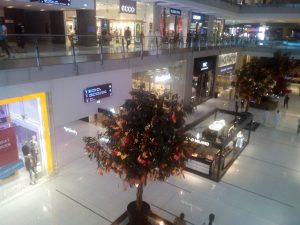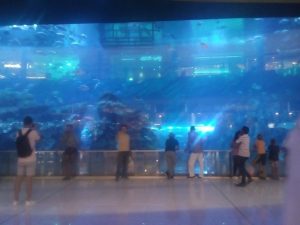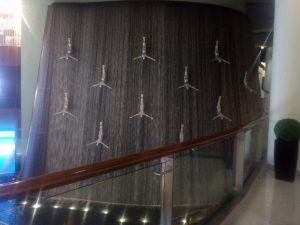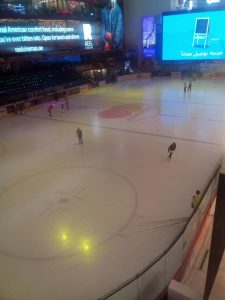“The Dubai Mall – A place like no other. A new day, a new dawn.
From the wind swept sands, a new legend rises. A mall of epic proportions that is named The Dubai Mall”.[1]
Professor John Bryson presents his final blog from Dubai:
‘I am based in Dubai for ten days getting to know this place. This is an exercise in “reading a city-region”[2] rather than “seeing like a city”[3]. These are very different activities – seeing and reading. I need to see the city, to experience the city, to read it. I don’t know how to ‘see like a city’; cities can’t see, or can they? Perhaps seeing like a city is an account of a smart sensor-enabled city. A monitored city.
The Dubai Mall is many things – a substantial piece of real estate – for property development and investment, an engineered space, a brand, a service space, an experience space, a working space and often a comparatively low-wage space. This is quite some mall, but it is still only the second-largest mall in the world. Visiting a mall is a geography lesson in global flows of fast-moving consumer products – from food to cosmetics to fashion – and in people flows from across the world. Every year more than 80 million visitors stroll through this place, and one year this was the most visited building on this planet.

This mall has 3.77 million sq. ft. of lettable space and over 1,300 retail outlets including two anchor department stores, Bloomingdale’s and Galeries Lafayette (Photograph 1). A visit to The Dubai Mall comes with opportunities for some serious shopping and eating. There are over 200 food outlets. Think about these statistics. A ten-minute stroll in each store would amount to a visit of over 10.4 days, but these are 24-hour days! But, we are in luck as this mall is only open from 10am to midnight – 14 hours, seven days a week. This means my ten-minute visit to each store will take me 17.8 days, but I will need time to eat, and sleep. The Dubai Mall provides everything the mall explorer could want – from charging stations, to a porter service and a sleeping pod lounge.

There are many aspects to this mall. There is shopping, eating, strolling and entertainment. The mall includes the Dubai Aquarium & Underwater Zoo with a 270-degree walk-through tunnel (Photograph 2); the VR Park for virtual reality; KidZania® an ‘edutainment’ experience targeted at children; the Reel Cinemas megaplex; the Olympic-sized Dubai Ice Rink, Dino the Dinosaur and the Waterfall (Photograph 3).

The Dubai Mall is part of a much larger property development intended to attract shoppers and tourists seeking experiences. This mall is part of the large-scale, mixed use Downtown Dubai development. This is a 2 sq. km. development that includes the tallest building in the world, Burj Khalifa, the Dubai Fountain – the world’s largest choreographed fountain system, and The Dubai Mall. There is no question that this is a cosmopolitan place, a theatrical place, a servicescape and an experience scape[4].
There are many sides to Downtown Dubai. On the one hand, there is the fountain. This is a piece of America that will always be Dubai. It was designed by WET Design, the Californian company that designs water features across the U.S., including Las Vegas. The Fountain is a transposition of Las Vegas to Dubai. Alternatively, the Burj Khalifa comes alive at night with a dramatic lighting show (as demonstrated in the above video). The lighting was designed by Jonathan Speirs, co-founder of Speirs + Major, a UK lighting design consultancy. The design of Downtown Dubai is a lesson in the internationalisation of architectural and related design services. Both the fountain and the lighting show reveal another side to this place – free entertainment for all.
How do we read The Dubai Mall? Perhaps, in the same way as we read a city-region[5], but a mall is a microcosm. It is a place that is simultaneously real and artificial, a carefully crafted and designed retail and experience space, but a private space and, yes, a monitored space. A space of cameras – a safe and secure place. This is a place of contrasts. I strolled through the mall last Saturday at 7pm and again at 10pm. There were many experiences – from the Aquarium to watching ice skating (Photograph 4).

I stood by one of the entrances – waiting and watching many people – mainly couples – enter and leave this crafted space. This was a concentrated space of flows. One thing was apparent, very few strollers leaving this mall had any indication that they had shopped. But, it was Saturday night. There were very few carrying shopping bags. But, remember this is also an entertainment and eating place.
I want to raise two points about this place of many potential experiences. First, retail habits are changing; visits to shopping centres are less frequent, but of longer duration and over greater distances – from Birmingham to Dubai! The retail mix within large shopping centres is changing; ten years ago, food and drink outlets would account for 5% of outlets but today developers aim for at least 20% (The Dubai Mall is over 13%). This highlights the on-going transformation of shopping centres into leisure spaces that are saturated with service experiences, or just food[6].
Second, one reading of retail is about the decline of the high street and of the shopping mall as e-commerce continues to transform shopping. It is interesting to note that the rise and decline of the high street shop has occurred over a relatively short time. Shops, as we know them, only emerged in the later part of the 17th century. Prior to this, goods were purchased from temporary stalls set up in market places or from ‘shops’ without glass windows. Instead, they were protected outside working hours by window-shutters that were let down and when open, supported on posts, for the display of goods. The word ‘shop’ only emerged as a verb with the meaning of going to purchase goods in the mid-18th century (1764); prior to this the term meant to expose goods for sale or a workshop. The rise of e-commence is partly behind the shift away from shopping to consume goods to shopping to consume experiences. Shopping malls become places to explore products that are then purchased on-line, perhaps click and collected, but too often returned.
Malls are places designed to encourage us to consume. Within the confines of The Dubai Mall the tourist can gaze and consume a variety of different landscapes, entertainments and shops. Malls are spaces in which to see and to be seen[7]. ‘Consumers’ can enter the world of the mall and pretend that they have just shopped or are just about to shop or consume. They can gaze, stroll and be gazed upon consuming the space rather than relating to the mall as a place of consumption[8]. This is a form of resistance that implies that the psycho-geographers that design malls may have been too successful. Consumers of mall space increasingly consider a mall to be a real rather than a form of artificial public space. The public street, or the square, has been translocated in to a form of enclosed, private place – a private place that masquerades as a public place.
Reading a mall is an exercise in reading life. Strolling through the mall are shop assistants, entertainment creators, cleaners, security guards, mall guides and couples, families, and friends; all strangers who come together to explore this very carefully designed and designer enclosed place. The whole world comes to The Dubai Mall, but what do visitors take away? Presents, products, food and memories; memories of a time spent in a place of theatre, a place of over 1500 shops and Dino the Dinosaur.’
[1] https://thedubaimall.com/en/about-us/about-the-dubai-mall, accessed 4 October 2018
[2] Bryson J.R., Andres, L and Mulhall, R. (Eds), (2018), A Research Agenda for Regeneration Economies: Reading City-Regions, Edward Elgar, in press; Leach, J.M., Mulhall, R.A., Rogers C.D.F. and Bryson J.R. (2018), Reading Cities: Developing an Urban Diagnostics Approach for Identifying Integrated Urban Problems with Application to the City of Birmingham, UK. Cities, in press.
[3] Amin, A. and Thrift, N. (2017), Seeing Like a City, Polity: Cambridge.
[4] Sundbo, J. (2015), ‘Service and experience’, in J.R. Bryson and P.W. Daniels (eds), Handbook of Service Business, Edward Elgar: Cheltenham: 205-222; Sundbo, J. and Darmer, P. (eds.) (2008), Creating Experiences in the Experience Economy, Cheltenham: Edward Elgar; Sundbo, J. and Sørensen, F. (Eds.) (2013), Handbook on the Experience Economy, Cheltenham: Edward Elgar.
[5] Bryson J.R., Andres, L and Mulhall, R. (Eds), (2018), A Research Agenda for Regeneration Economies: Reading City-Regions, Edward Elgar, in press.
[6] Bryson J.R. and Daniels, P.W. (2015), ‘Service Business: Growth innovation, competitiveness, in Bryson J.R. and Daniels P.W. (2015), Handbook of Service Business: Management, Marketing, Innovation and Internationalisation, Edward Elgar: Cheltenham, 1-20
[7] Bryson, J.R., Daniels, P.W. and Warf, B. (2004) Service Worlds: People, Organizations, Technologies, Routledge: London
[8] Shields, R. (1989) ‘Social spatialization and the built environment: the West Edmonton Mall’, Environment and Planning D, Society and Space, vol 7, 147-164
This blog was written by Professor John Bryson, City-REDI, University of Birmingham.
Disclaimer:
The views expressed in this analysis post are those of the authors and not necessarily those of City-REDI or the University of Birmingham.
To sign up for our blog mailing list, please click here.
